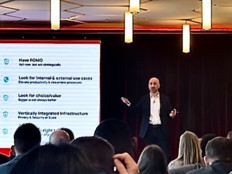With financial regulations and reporting requirements soaring, it might seem that a financial institution’s ability to monitor and comply with regulations is more than anyone could handle.
And there is a lot at stake. Financial industry regulators are coming down hard on financial institutions. The Securities and Exchange Commission, for example, levied $6.4 billion in penalties across 760 enforcement actions in fiscal year 2022, the most ever for the SEC.
Fortunately, humans don’t have to go it alone: Thanks to regulatory technology (RegTech), financial institutions can be more efficient in how they identify fraud and manage regulatory compliance.
Here’s a look at the technology and how it is improving financial businesses.
FIND OUT: Learn how to achieve IT compliance in a modern landscape.
What Is RegTech?
RegTech is the use of emerging technologies such as AI, machine learning and blockchain to help financial institutions with regulatory monitoring and compliance.
Financial institutions receive a range of services from RegTech companies via Software as a Service. By hiring these essential services, financial firms can save time and money.
Cloud computing makes it possible, as RegTech requires a large amount of data that can’t be stored in legacy systems. Once the cloud and Big Data are operating in unison, organizations can use RegTech as a cost-effective solution to stay compliant.
How does it work? RegTech companies use AI to automate tasks and access data that might be out of reach to personnel. It then processes the data at lightning-fast speeds. The system monitors activity in near real time and can flag potential issues for analysis, whether it’s regulatory compliance problems or fraudulent activity.
Besides reviewing historical data, RegTech companies apply machine learning to scan for regulatory failures in the system. Once failures are detected, the system can predict and prevent possible risk as it examines data.
Click the banner below to learn how a modern data platform supports smart decision-making.


What Is the History of RegTech?
RegTech has deep roots in the financial industry. Its history traces back to one of the most significant financial regulatory reforms in U.S. history: the Dodd-Frank Wall Street Reform and Consumer Protection Act of 2010, passed in response to the 2007-2008 financial crisis.
The many regulations born of Dodd-Frank and in the years since its passage have left financial institutions struggling to stay compliant, especially in an era when online banking and automated trading has boomed, further exposing financial firms to data breaches and fraudulent activities, contributing to the regulatory burden.
The 2010s also saw the rise of AI and machine learning. One of AI’s core strengths lies in its ability to comb through incalculable amounts of data and look for trends and anomalies faster than any human could. This technology can also complete complex tasks instantly. Over the years, as the technology has improved and become more reliable, more financial institutions have embraced it.
RELATED: Fnancial institutions are using AI to navigate regulations.
Although there are hints that RegTech’s use is waning among financial institutions, according to Thomson Reuters Regulatory Intelligence, some sources expect it to continue to grow. For example, Juniper Research predicts a 124 percent increase in global spending on RegTech, from $83 billion in 2023 to $207 billion 2028.
Regulators are using the tech too. When regulators and financial firms both use RegTech there is a greater chance of alignment and better overall communication.
As Ernst & Young explains: “Regulators, RegTech firms, professional service organizations and financial institutions will all need to work together in an effort to continue innovation, reduce overall costs of compliance, and accurately and effectively report to the regulators.”
124%
The percentage increase in global spending on RegTech expected between 2023 and 2028
Source: Juniper Research, “RegTech: Market Forecasts, Trends and Strategies,” December 2023
What Applications Make Up RegTech?
Financial institutions usually dedicate significant resources to regulatory compliance. By partnering with RegTech companies, institutions stand to reduce the burden on staff by eliminating the need for a manual data review. RegTech companies also use automated systems to package user-defined sets of data for analysis, decision-making and reporting.
DISCOVER: Is your security strong enough for GDPR compliance?
Here are some examples of how RegTech is being used in the financial sector.
Regulatory inventory: RegTech can search through vast catalogs of financial regulations, identify the regulations that a financial firm must comply with, cross-reference the regulations with the firm’s own policies and controls, and assess the firm’s compliance with the regulations.
Regulatory reporting: RegTech automatically generates standardized reports, streamlines data flow and establishes validation controls.
Identity management: RegTech can verify identity and authenticate users to comply with “know your customer” requirements and can continuously monitor transactions for fraudulent activity.
Risk management: By flagging trends and anomalies quickly, RegTech can help financial firms keep up with an ever-changing and ever-expanding web of risks, including data breaches, cyberattacks and fraud.
Reputation monitoring: Risk management extends to the financial institution’s reputation. RegTech can scan social media and traditional news sites for changes in public perception of the organization.
Maxxa_Satori/Getty Images










